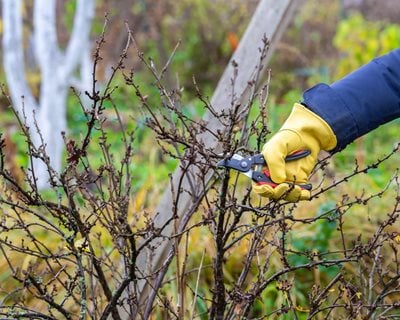10 Common Pruning Mistakes & How to Avoid Them
Fine tune your pruning skills for happy and healthy plants
Photo by: S.O.E. / Shutterstock.
While proper pruning can enhance the beauty and health of your shrubs, common mistakes can lead to unintended consequences. Whether you're a novice gardener or have years of experience, it's easy to make mistakes that may harm your plants. But, by understanding these common missteps, you'll be better equipped to prune with confidence.
Here are 10 common pruning errors and how you can avoid them:
1. OVER-PRUNING:
Removing too much foliage at once can stress the plant and reduce its ability to photosynthesize.
How to avoid: Follow the general rule of never removing more than one-third of the plant’s foliage in a single pruning session. This helps ensure the plant retains enough leaves to sustain healthy growth.
2. PRUNING AT THE WRONG TIME:
Pruning at inappropriate times can result in fewer flowers or weakened plants.
How to avoid: Research the best times to prune each type of shrub. As a general rule, prune spring-flowering shrubs immediately after they bloom and summer-flowering shrubs in late winter or early spring. (See this seasonal shrub pruning guide for more details.)
3. USING IMPROPER TOOLS:
Dull or dirty tools can make jagged cuts that invite disease and pests.
How to avoid: Always use sharp, clean pruning tools. Regularly sharpen blades and sanitize them with a disinfectant before and after use to prevent the spread of disease. (See more on pruning tools.)
4. CUTTING TOO CLOSE TO THE BUD:
Cutting too close can damage the bud, preventing new growth.
How to avoid: When making heading cuts, leave a small stub (about ¼ inch) above the bud to protect it. This encourages healthy new growth from the bud.
5. REMOVING THE BRANCH COLLAR:
Cutting off the branch collar (the swollen area where the branch meets the trunk or another branch) can impair the shrub’s ability to callus over and make it more susceptible to disease.
How to avoid: Make cuts just outside the branch collar. This helps the shrub callus the wound and recover more effectively.
6. IGNORING PLANT HEALTH:
Failing to consider the overall health of the plant can lead to increased stress and vulnerability to disease.
How to avoid: Before pruning, assess the plant’s health and ensure its well-watered and not under stress from pests or disease. Healthy plants recover better from pruning.
7. IMPROPER THINNING:
Removing too many inner branches can lead to a sparse, weakened structure and susceptibility to sunscald.
How to avoid: Thin selectively, removing only the branches that are necessary to improve air circulation and light penetration. Avoid creating large gaps in the canopy.
8. IGNORING PLANT GROWTH HABIT:
Not considering the natural growth habit of the shrub can result in an unnatural shape and poor health.
How to avoid: Prune in a way that respects the natural shape of the shrub. For instance, some shrubs have a natural vase shape, while others grow more upright or spreading.
9. NOT CLEANING UP DEBRIS:
Remove prunign debris promptly, especially diseased leaves and branches.
How to avoid: Always clean up and dispose of pruned debris properly. Some debris can be composted; diseased materials should be disposed of in green waste. This helps maintain a healthy garden environment and reduces the risk of pests and diseases.
10. INCORRECT WOUND TREATMENT:
Applying wound dressing or sealant usually does more harm than good.
How to avoid: In most cases, it’s best to leave pruning cuts to heal naturally. Avoid using wound dressings unless recommended for specific situations by a professional.
RELATED:
Pruning Guides
How, When, & Why to Prune Your Shrubs
Pruning Shrubs: A Seasonal Guide
6 Essential Tools for Pruning
